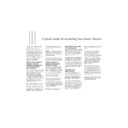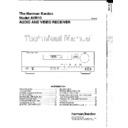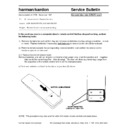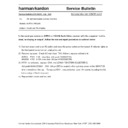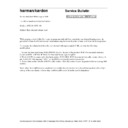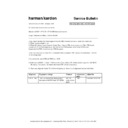Read Harman Kardon AVAP1G (serv.man6) User Guide / Operation Manual online
The AVR10 is a control center that is
complete with all the amplifiers and
signal processing you will need to
transform the stereo signal from a video
source into a home theater system.
Simply plug the audio outputs from your
television, VCR or laser disc into the
designated inputs on the AVR10. Then
connect the surround, center, front
speakers and optional subwoofer to the
outputs on your AVR10 and you are
ready to enjoy an exciting new
experience – home theater.
complete with all the amplifiers and
signal processing you will need to
transform the stereo signal from a video
source into a home theater system.
Simply plug the audio outputs from your
television, VCR or laser disc into the
designated inputs on the AVR10. Then
connect the surround, center, front
speakers and optional subwoofer to the
outputs on your AVR10 and you are
ready to enjoy an exciting new
experience – home theater.
WHAT YOU WILL NEED TO
CONNECT TO YOUR
HARMAN KARDON AVR10
FOR HOME THEATER
APPLICATIONS
CONNECT TO YOUR
HARMAN KARDON AVR10
FOR HOME THEATER
APPLICATIONS
TV – If you have a stereo television with
stereo audio output connections, you will
be able to connect it directly to the
AVR10 using the TV/Aux inputs. No
other input devices will be needed. If
the TV does not have these outputs or
is not stereo, you will have to connect it
to your VCR and then connect your VCR
to the VCR1 or VCR2 input on the
AVR10, according to the instructions
supplied with your VCR.
stereo audio output connections, you will
be able to connect it directly to the
AVR10 using the TV/Aux inputs. No
other input devices will be needed. If
the TV does not have these outputs or
is not stereo, you will have to connect it
to your VCR and then connect your VCR
to the VCR1 or VCR2 input on the
AVR10, according to the instructions
supplied with your VCR.
VCR – To play video tapes in Surround
Sound, you will need a hi-fi stereo VCR.
If your TV is not stereo or does not have
audio outputs, your VCR must also have
a multiplex decoder. The instructions
supplied with your VCR will identify these
features. For best results, hook up the
Sound, you will need a hi-fi stereo VCR.
If your TV is not stereo or does not have
audio outputs, your VCR must also have
a multiplex decoder. The instructions
supplied with your VCR will identify these
features. For best results, hook up the
VCR’s audio outputs directly to the
receiver and switch to VCR1 or VCR2
while playing a tape.
receiver and switch to VCR1 or VCR2
while playing a tape.
Speakers – You will need two main
speakers for left and right front channels,
a center speaker and two surround
speakers. You may also want to connect
a powered subwoofer.
speakers for left and right front channels,
a center speaker and two surround
speakers. You may also want to connect
a powered subwoofer.
You can connect up to three additional
sources to the AVR10 including a laser
disc, CD player and audio cassette deck.
sources to the AVR10 including a laser
disc, CD player and audio cassette deck.
GETTING READY TO
LISTEN TO YOUR HOME
THEATER SYSTEM
LISTEN TO YOUR HOME
THEATER SYSTEM
Once you have completed the connec-
tions more fully described on pages 5
thru 7 in the enclosed AVR10 Owner’s
Manual, you’ll need to select the signal
source you want it to play. If you want to
listen to your VCR, press the VCR button
on the front panel. Each of the front
panel controls is described in pages 3
and 4 of your Owner’s Manual.
tions more fully described on pages 5
thru 7 in the enclosed AVR10 Owner’s
Manual, you’ll need to select the signal
source you want it to play. If you want to
listen to your VCR, press the VCR button
on the front panel. Each of the front
panel controls is described in pages 3
and 4 of your Owner’s Manual.
Now you will need to select how you
want to listen to your input signal: in
stereo, Dolby 3 stereo or Dolby Pro
Logic Surround. You will find a descrip-
tion of these listening options on page 10
of the Owner’s Manual. On pages 3 and
4, you will find descriptions of the buttons
that control these options.
want to listen to your input signal: in
stereo, Dolby 3 stereo or Dolby Pro
Logic Surround. You will find a descrip-
tion of these listening options on page 10
of the Owner’s Manual. On pages 3 and
4, you will find descriptions of the buttons
that control these options.
All of these functions and more can be
controlled by the remote control.
controlled by the remote control.
BALANCING THE VOLUME
OF THE SPEAKERS
OF THE SPEAKERS
Press the Test Tone button on the remote
control, described on pages 14 and 15 of
your Owner’s Manual. A tone will be
audible for a few seconds sequentially
on the left, then center, then right and
finally on both surrounds.
control, described on pages 14 and 15 of
your Owner’s Manual. A tone will be
audible for a few seconds sequentially
on the left, then center, then right and
finally on both surrounds.
Using the balance control on the front of
the AVR10, balance the front left and
right speakers so that they are about the
same volume. Then, seated at your lis-
tening spot, adjust the volume levels for
the center and surround speakers so that
they are about the same volume as your
front right and left speakers. Depress the
test tone button again to turn the test
tone off.
the AVR10, balance the front left and
right speakers so that they are about the
same volume. Then, seated at your lis-
tening spot, adjust the volume levels for
the center and surround speakers so that
they are about the same volume as your
front right and left speakers. Depress the
test tone button again to turn the test
tone off.
ENJOYING YOUR
HOME THEATER
HOME THEATER
If you have decided to listen to your
AVR10 in Dolby Pro Logic Surround, you
must have a Dolby Surround-encoded
tape, disc or broadcast. These are
almost always identified as recorded or
broadcasted in “Surround Sound.”
AVR10 in Dolby Pro Logic Surround, you
must have a Dolby Surround-encoded
tape, disc or broadcast. These are
almost always identified as recorded or
broadcasted in “Surround Sound.”
When properly balanced in Pro Logic
Surround, most of the sound associated
with the action that is on the TV should
be coming from the center speaker. Most
dialog comes from the center speaker. It
is generally the loudest speaker in the
system. Off-screen sounds should be
coming from your main right and left
Surround, most of the sound associated
with the action that is on the TV should
be coming from the center speaker. Most
dialog comes from the center speaker. It
is generally the loudest speaker in the
system. Off-screen sounds should be
coming from your main right and left
speakers. Sounds intended to be behind
you should come from the surround
speakers.
you should come from the surround
speakers.
Many people are confused about the
function of the surround or rear chan-
nels. The surround channels are
designed to add ambient information
function of the surround or rear chan-
nels. The surround channels are
designed to add ambient information
to
the listening experience. This effect will
vary from source to source as well as
from program to program.
vary from source to source as well as
from program to program.
If the source
material you have selected is broadcast
in mono, if your VCR is mono, or the
tape is mono, the rear channels will
receive no signal and therefore will
produce no sound.
in mono, if your VCR is mono, or the
tape is mono, the rear channels will
receive no signal and therefore will
produce no sound.
When surrounds are part of the play-
back, they can be distracting if they are
too loud; they draw your attention away
from the action and sounds in front of
you. They are supposed to be at a much
lower volume than the front speakers.
Generally, you should not be able to dis-
tinctly pick out sounds coming directly
from the rear speakers.
back, they can be distracting if they are
too loud; they draw your attention away
from the action and sounds in front of
you. They are supposed to be at a much
lower volume than the front speakers.
Generally, you should not be able to dis-
tinctly pick out sounds coming directly
from the rear speakers.
Now sit back, turn the volume up a little
and get ready to enjoy your TV like you
have never enjoyed it before!
and get ready to enjoy your TV like you
have never enjoyed it before!
A Quick Guide To Installing Your Home Theater
AVR10 Insert Sheet 12/21/98 4:19 PM Page 1
Display

